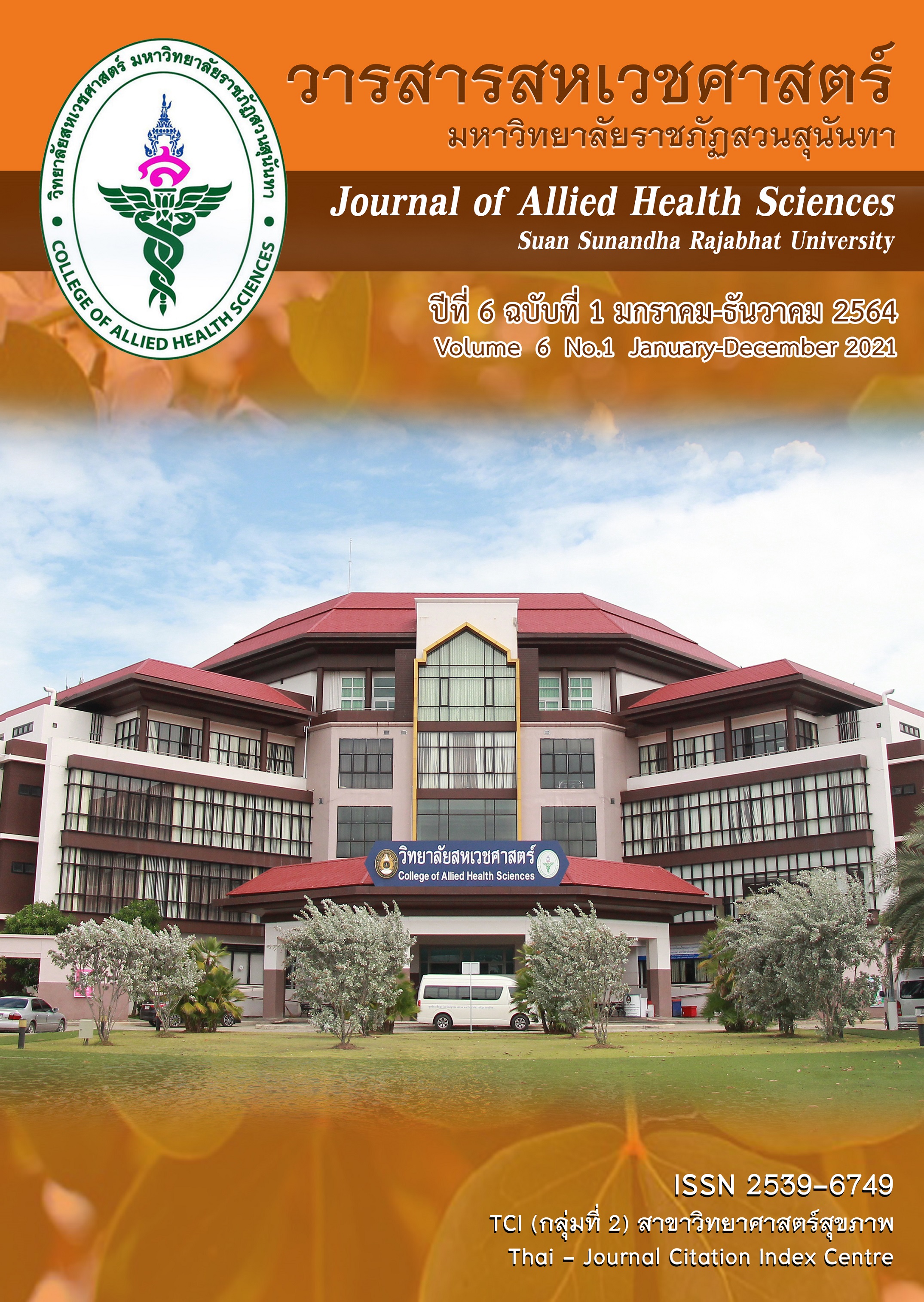ปัจจัยอากาศที่มีผลต่อปริมาณจุลินทรีย์ในอากาศที่ส่งผลกระทบ ต่อสุขภาพพนักงานในโรงฆ่าสุกร Air Factors Affecting Airborne Microorganisms Affecting Employee Health in Pig Slaughterhouse.
Main Article Content
บทคัดย่อ
การวิจัยนี้มีวัตถุประสงค์เพื่อศึกษาปัจจัยทางอากาศต่อปริมาณเชื้อราและแบคทีเรียรวมในอากาศ
และแบคทีเรียก่อโรคในเนื้อสุกร ในโรงฆ่าสุกรขนาดต่างๆ ที่ส่งผลกระทบต่อสุขภาพของพนักงานที่ทำงาน
ในโรงฆ่าสุกร ซึ่งกลุ่มตัวอย่างที่ทำการศึกษามีทั้งหมด 3 แห่ง โดยแบ่งออกเป็น 3 ขนาด ได้แก่ ขนาดเล็ก คือ
โรงฆ่าสุกรป๋าใหญ่ จังหวัดกรุงเทพมหานครฯ ขนาดกลาง คือ โรงฆ่าสุกรกรุงเทพมหานคร 2 จังหวัดกรุงเทพมหานครฯ และขนาดใหญ่ คือ โรงฆ่าสุกรเทศบาลตำบลสำโรงเหนือ จังหวัดสมุทรปราการ โดยเก็บตัวอย่างโรงละ 4 จุด คือ จุดที่มีการเอาเลือดออก จุดที่มีการลวกหนัง ลอกหนัง และถอน/ขูดขน จุดที่มีการเอาเครื่องในออก และจุดควบคุม (ห้องบริหารงานทั่วไป) โดยทำการเก็บตัวอย่างจุลินทรีย์ในอากาศในจุดที่กำหนด ด้วยเครื่อง Microflow Alfa 90 แล้วนำผลการเพาะเชื้อในห้องปฏิบัติการมาเทียบกับค่ามาตรฐาน ผลการศึกษา พบว่า ปริมาณของเชื้อรารวมในโรงฆ่าสุกรจำนวนทั้ง 3 แห่ง มีค่าเกินมาตรฐาน ส่วนปริมาณแบคทีเรียรวม
ในโรงฆ่าขนาดกลางและขนาดใหญ่พบว่ามีค่าเกินมาตรฐานบริเวณที่มีการเอาเลือดออก บริเวณที่มีการเอาเครื่องในออก บริเวณที่มีการลวกหนัง และถอน/ขูดขน นอกจากนี้ในโรงฆ่าขนาดกลางและขนาดใหญ่ยังพบปริมาณ Salmonella spp. และ S. aureus ในตัวอย่างเนื้อสุกร ที่ผ่านเกณฑ์มาตรฐานของกรมปศุสัตว์ ร้อยละ 27.21 และ 67 ตามลำดับ จึงอาจทำให้มีความเสี่ยงในการรับสัมผัสเชื้อจุลินทรีย์และอาจเกิดผลกระทบต่อสุขภาพพนักงานในโรงฆ่าสุกรได้ ซึ่งจะต้องมีการปรับปรุง ป้องกัน และแก้ไขต่อไป
The Objective of this research is to study the air factors on the amount of airborne mold, bacteria and pathogenic bacteria in pig meat and in various sizes of slaughterhouses. Which was affecting the health of employees who work in the pig slaughterhouse. The studied groups of samples comprising of 3 places that can be divided into 3 sizes including small, namely, a large slaughterhouse. In Bangkok, the medium size is the slaughterhouse in Bangkok, 2 provinces of Bangkok, and the large one is the slaughterhouse at Samrong Nuea Sub-District Municipality. SamutPrakan Province. Three sets of air borne microorganisms samples were collected from four points in each slaughterhouse, including the point where blood is removed, the point where skin is boiled, the point where peeled and hair
is removed, the point where entrails are removed and the general administration office. The samples of air from these points were collected by using Micro flow Alfa 90 and the culture results from laboratory were then compared with the standard values. The result reveals that the total number
of molds from the collected samples of three slaughterhouses exceeded the standard. The total number of bacteria in three size slaughterhouses which exceeds the standard value includes the point where blood is removed. The total bacterial count in medium and large slaughter houses found to exceed the standard was the area where the internals are removed, area where the skin is scalded, and the plucking and scraping area. In addition, both of then landed in medium and large slaughter house have Salmonella spp. and S. aureus content was also found in the pork sample 27.21 % and 67 %, respectively. Therefore, there may be a risk of exposure to microorganisms and may affect the health
of employees in the pig slaughter house. Therefore, It must be improve prevented and corrected further.

